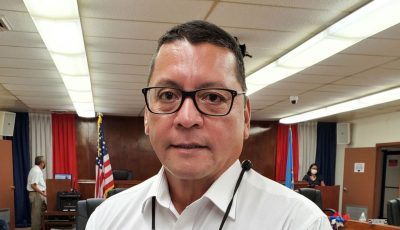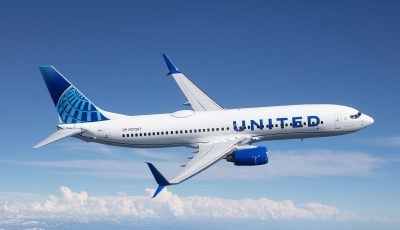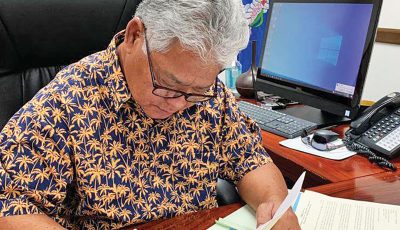FY ’17 budget in; 10-pct increase from last year
Gov. Ralph DLG Torres has sent his proposed budget for fiscal year 2017 to the Legislature, marking up $127.8 million available for the general budget.
After adjustments, the budget is an increase of $14,986,250, or a 10-percent increase from last fiscal year. Gross budgetary resources for fiscal 2017 are at $203.42 million.
“This is a result of the continued considerable growth of our tourism economy persistent with the opening of new establishments triggering an increase in our tax collections across the board,” said Gov. Ralph DLG Torres in his 15-page budget transmittal letter to the House of Representatives and Senate.
Among others, the Torres administration provides funding for the CNMI’s new drug court program, judgments against government obligations, and also proposes a plan and funding to raise salaries for law enforcement across the board for the first time in years.
The budget also provides some funding for recovery groups to build typhoon-proof homes after Typhoon Soudelor and provides funding in anticipation for the increase in minimum wage and enactment of a House bill that would raise classified employees salaries in government slightly across the board.
The Public School System will get 25 percent of the net available budget as mandated per House Legislative Initiative 18-12, or $31.95 million. The Northern Marianas College is allocated $4 million.
Fiscal climate
Torres says that tourism will continue to contribute to the economy throughout the new fiscal year, noting an expected increase in airlines seats as early as this June and an additional 313 hotel rooms with the opening of the Kensington Hotel, that will “positively allow potential growth in arrivals.”
Torres also notes that “Phase 1” of the integrated resort, or the casino resort industry, is “showing advance progress” and anticipates opening in the first quarter FY 2017. This will increase the number of hotel rooms in the market, and introduce new activities and products to tourists and local consumers.
“The opening of these new establishments is a promising indication of our continued economic growth” and will have an impact on tax collections that have been factored favorably into the enclosed budget proposal, Torres said.
Torres said his administration would continue to strengthen enforcement actions among government agencies to support the increased economic activity.
“During the next three years, it is essential that our government focus its efforts toward mitigating areas and entities which may potentially hinder growth if alternative solutions are not in place,” Torres said. “Among these areas include the most pressing workforce issues facing the Commonwealth. We must collectively work together with our federal partners in our extension testimony to allow contractor workers beyond 2019. Without this, we will significantly place our economy in jeopardy,” Torres said.
FY 2017’s $203.42 million identified budget resources is broken down into $74.8 million from business gross tax revenue, or 37 percent of total resources; $41.8 million from incomes taxes, or 21 percent; $35.585 million from excise taxes, or 17 percent; and $29.178 million from other taxes, or 14 percent.
It is also broken down into $14.14 million from licenses and fees, $1.575 million from charges for services, and $6.31 million from other revenue sources.
Budget strategy
Torres says their approach to the development of the budget is to satisfy public school funding mandates and maintain funding in every department and agencies. “Departments were directed to asses their programs and curtail or eliminate non-essential spending,” Torres said.
They took several approaches: first, examine past and current activities to “ensure minimum allocation” for the delivery of public services; they kept all vacancies for critical and essential programs; and lastly they re-evaluated “the results” for each department and agency and allocated funding to the most critical and essential programs.
This proposal validated by the budget worksheets enclosed is the net result of the funding requested by the departments and activities, which exceed available resources by $16.7 million.
In accordance with my constitutional duty to maintain a balanced budget, critical activities and programs were considered in this proposal.
Accordingly, this budget submission illustrates the following underlying assumptions and considerations: applied 25 percent of net general fund revenues to the Public School System; increased funding for active retirees Group Health and Life Insurance, or $351,000; inclusion of funding for 45 new NOPs and salary adjustments for all law enforcement officers; inclusion of funding for the CNMI Drug Court under the CNMI Judiciary; $500,000 for judgments against the government, and $500,000 for Substance Abuse Recovery Program.
It also includes, among others, funded utilities based on FY 2015 current level; funded utilities for the Public School System and the Commonwealth Healthcare Corp.; establishing the Commonwealth Advocates for Recovery Efforts (CARE) Program; inclusion of increase in the federal minimum wage from $6.05 per hour to $6.55 per hour this; inclusion of the projected funding impact of House Bill 19-003, which proposes salary increase for government; and increased funding toward the Scholarship Program, or $300,000.
The effects of the above result in net expenditure budget of $134,988,731.
This net excludes moneys spent to be absorbed from Compact Impact reimbursements and transfer of eligible expenditures into non-general fund sources amounting to $2.3 million and $4.87 million, respectively.
The net operating budget for appropriation is $127.806 million.
Earmarks
Revenue transfers to earmarked funds, which include cancer, hotel tax, tobacco funds, and special accounts to the senatorial districts, among others, amount to $34.197 million.
The 2007A Refunding bond payments and 2007B refunding bond payment amounts to $5.148 million and $3.27 million, respectively, while $33 million goes to the service of debt for the settlement fund agreement.
Together, these total $75.62 million.
Budget spread
Breaking it down into personnel, all others, and utilities costs, $63,161,485 of the budget, or 48 percent, will go to personnel, $58.18 million go to ‘all others,” and $10.74 to utilities.
Under government activities uses categories, $12.75 million is allocated to the “health,” while $20.66 million goes to public safety and enforcement.
Some $21.45 million goes to general government, and $2.14 goes to the “other elected officials” category.
Another $3.735 million goes to community and social services, $3.36 million to public works and $3.948 million to lands and natural resources categories, and $4.82 million to the legislative branch.
Some $4.77 million goes to the judicial branch, and “education,” which includes public schools, its board, the local college, and scholarship office, gets $37.79 million, or 29 percent of the allocations.
About $1.65 million heads to categories under economic development, 410.747 goes to utilities, and $4.23 million go to autonomous agencies.
More details
The Torres administration allocates $6.32 million from combined group health and life insurance for active employees and retirees, $2.47 million of which is specifically for active employees who opted to remain with the government’s insurance provider.
For the defined benefit (DB) contribution plan, a sum of $183,356 is included for all DB members within the central government.
The Torres administration also signals raises for law enforcement and first responder.
“It is the intent of the administration to fulfill an equitable salary adjustment for law enforcement/first responders personnel to be accomplished in three separate phase,” Torres said.
Phase 1 is a reallocation for law enforcement/first responders earning less than $25,000; Phase 2 is reallocation for all other law enforcement/first responders earning in excess of $25,000; and Phase 3 is reallocation for all other law enforcement/first responders not included in the prior phases.
This proposal provides funding for the first two phases specifically for the departments of Public Safety, Fire and Emergency Medical Services, Corrections, Finance, and its Division of Customs. The proposal does not count for unsworn officers or any administrative personnel.
“A cumulative total in excess of $3.5 million for the salary adjustments of these law enforcement…is included in this proposal including new positions to support anticipated increase in tourism activities,” Torres said.
The budget also allocates $253,470 to meet the funding mandates for the Drug Court Act of 2015, which programs rehabilitate and help recovering drug offenders.
The budget also includes $500,000 to funding for a percentage of past and current government liabilities to pay for these outstanding debts. A plan will be developed in consultation with the Office of the Attorney General on how the government should proceed with the distribution of this funding, Torres said.
The Torres administration also sets aside $500,000 for the implementation of a “Substance Abuse and Rehabilitation Program” for the hiring of treatment specialists and caseworkers to support an on-island treatment program for those that do not require an intensive in-patient treatment abroad.
The administration commits $303,000 to CARE for repairs and rebuilding typhoon proof homes for families with unmet housing needs.
The budget includes the implementation of a $.50-increase to the minimum wage this September, estimating a impact to salary adjustments to a total 98 employees—31 on Rota, 66 Saipan, and one on Tinian—at $71,347.
The budget also includes allocation to “effectuate the impact” of House Bill 19-003, which amends public laws on salary compensation to provide a 3.25 increase across the board for all classified employees in all islands. The sum of $873,477 is included in the budget should the House bill be enacted in time for the fiscal year.
For medical referral, the administrative allocates $2.55 million. And Torres asks for lawmakers’ consideration to grant flexibility in reprogramming authority, calling it necessary when costs become uncontrollable to address the immediate need for these patients.
The budget sees 23 new positions for the Saipan, Tinian, and Rota municipalities, with eight for Rota, five for Tinian, and 10 for Saipan in support of community programs.
Funding of $2.662 million is allocated to the CHCC to help defray the cost of clinical services for the indigent population and medical care for the inmates incarcerated at the Department of Corrections.”
For the Public School System, the administration allocates the 25 percent of the budget mandated through House Legislative Initiative 18-12, or $31,951,656. On top of this, $4.5 is given for current and prior outstanding utilities costs.
The Northern Marianas College is allocated $4 million, and the CNMI Scholarship program $300,000.
The Torres administration also sets aside $100,000 to anticipated expenditures to assist department and agencies complement work on project worksheets to effect cost-shares approved by the Federal Emergency Management Agency, or FEMA, for Typhoon Soudelor.
About $1.6 million goes to the Department of Labor from Commonwealth Worker Fee Funds.



























